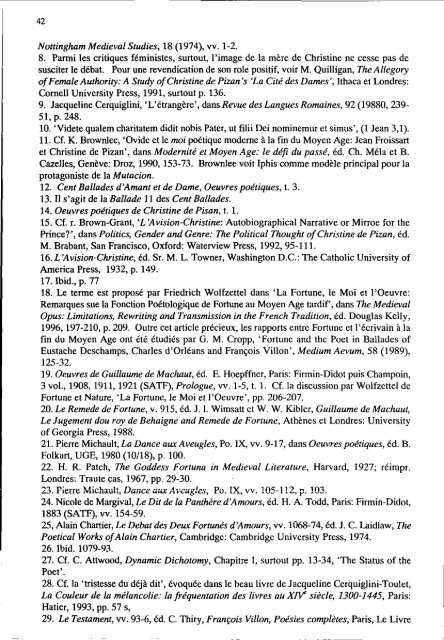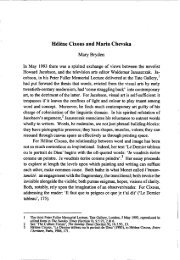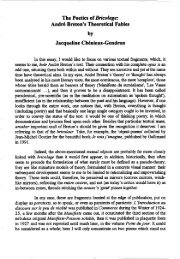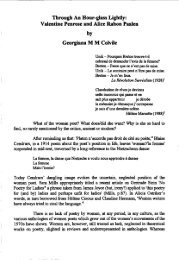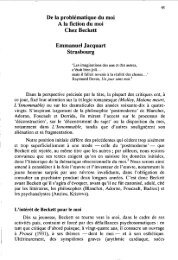Fortune et le 'moi' écrivant à la fin du Moyen Age: Autour de la ...
Fortune et le 'moi' écrivant à la fin du Moyen Age: Autour de la ...
Fortune et le 'moi' écrivant à la fin du Moyen Age: Autour de la ...
Create successful ePaper yourself
Turn your PDF publications into a flip-book with our unique Google optimized e-Paper software.
42<br />
Nottingham Medieval Studies, 18 (1974), vv. 1-2.<br />
8. Parmi <strong>le</strong>s critiques féministes, surtout, l’image <strong>de</strong> <strong>la</strong> mère <strong>de</strong> Christine ne cesse pas <strong>de</strong><br />
susciter <strong>le</strong> débat. Pour une revendication <strong>de</strong> son ro<strong>le</strong> positif, voir M. Quilligan, The Al<strong>le</strong>gory<br />
of Fema<strong>le</strong> Authority: A Study of Christine <strong>de</strong> Pizan’s ‘La Cité <strong>de</strong>s Dames’, Ithaca <strong>et</strong> Londres:<br />
Cornell University Press, 1991, surtout p. 136.<br />
9. Jacqueline Cerquiglini, ‘L‘étrangère’, dans Revue <strong>de</strong>s Langues Romaines, 92 (19880,239-<br />
51, p. 248.<br />
10. ‘Vid<strong>et</strong>e qua<strong>le</strong>m charitatem didit nobis Pater, ut filii Dei nominemur <strong>et</strong> simus’, (1 Jean 3,l).<br />
11. Cf. K. Brown<strong>le</strong>e, ‘Ovi<strong>de</strong> <strong>et</strong> <strong>le</strong> moi poétique mo<strong>de</strong>rne <strong>à</strong> <strong>la</strong> <strong>fin</strong> <strong>du</strong> <strong>Moyen</strong> <strong>Age</strong>: Jean Froissart<br />
<strong>et</strong> Christine <strong>de</strong> Pizan’, dans Mo<strong>de</strong>rnité <strong>et</strong> <strong>Moyen</strong> <strong>Age</strong>: <strong>le</strong> défi <strong>du</strong> passé, éd. Ch. Mé<strong>la</strong> <strong>et</strong> B.<br />
Cazel<strong>le</strong>s, Genève: Droz, 1990, 153-73. Brown<strong>le</strong>e voit Iphis comme modè<strong>le</strong> principal pour ia<br />
protagoniste <strong>de</strong> <strong>la</strong> Mutacion.<br />
12. Cent Bal<strong>la</strong><strong>de</strong>s d’Amant <strong>et</strong> <strong>de</strong> Dame, Oeuvrespoétiques, t. 3.<br />
13. I1 s’agit <strong>de</strong> <strong>la</strong> Bal<strong>la</strong><strong>de</strong> 11 <strong>de</strong>s Cent Bal<strong>la</strong><strong>de</strong>s.<br />
14. Oeuvrespoétiques <strong>de</strong> Christine <strong>de</strong> Pisan, t. 1.<br />
15. Cf. r. Brown-Grant, ‘L ’Avision-Christine: Autobiographical Narrative or Mirroe for the<br />
Prince?’, dans Politics, Gen<strong>de</strong>r and Genre: The Political Thought of Christine <strong>de</strong> Pizan, éd.<br />
M. Brabant, San Francisco, Oxford: Waterview Press, 1992,95-111.<br />
16. L’Avision-Christine, éd. Sr. M. L. Towner, Washington D.C.: The Catholic University of<br />
America Press, 1932, p. 149.<br />
17. Ibid., p. 77<br />
18. Le terme est proposé par Friedrich Wolfz<strong>et</strong>tel dans ‘La <strong>Fortune</strong>, <strong>le</strong> Moi <strong>et</strong> l’Oeuvre:<br />
Remarques sue <strong>la</strong> Fonction Poétologique <strong>de</strong> <strong>Fortune</strong> au <strong>Moyen</strong> <strong>Age</strong> tardif, dans The Medieval<br />
Opus: Limitations, Rewriting and Transmission in the French Tradition, éd. Doug<strong>la</strong>s Kelly,<br />
1996,197-210, p. 209. Outre c<strong>et</strong> artic<strong>le</strong> précieux, <strong>le</strong>s rapports entre <strong>Fortune</strong> <strong>et</strong> l’écrivain <strong>à</strong> <strong>la</strong><br />
<strong>fin</strong> <strong>du</strong> <strong>Moyen</strong> <strong>Age</strong> ont été étudiés par G. M. Cropp, ‘<strong>Fortune</strong> and the Po<strong>et</strong> in Bal<strong>la</strong><strong>de</strong>s of<br />
Eustache Deschamps, Char<strong>le</strong>s d’Orléans and François Villon’, Medium Aevum, 58 (1989),<br />
125-32.<br />
19. Oeuvres <strong>de</strong> Guil<strong>la</strong>ume <strong>de</strong> Machaut, éd. E. Hoepffner, Paris: Firmin-Didot puis Champoin,<br />
3 vol., 1908, 1911, 1921 (SATF), Prologue, vv. 1-5, t. 1. Cf. <strong>la</strong> discussion par Wolfz<strong>et</strong>tel <strong>de</strong><br />
<strong>Fortune</strong> <strong>et</strong> Nature, ‘La <strong>Fortune</strong>, <strong>le</strong> Moi <strong>et</strong> l’Oeuvre’, pp. 206-207.<br />
20. Le Reme<strong>de</strong> <strong>de</strong> <strong>Fortune</strong>, v. 915, éd. J. I. Wimsatt <strong>et</strong> W. W. Kib<strong>le</strong>r, Guil<strong>la</strong>ume <strong>de</strong> Machaut,<br />
Le Jugement dou roy <strong>de</strong> Behaigne and Reme<strong>de</strong> <strong>de</strong> <strong>Fortune</strong>, Athènes <strong>et</strong> Londres: University<br />
of Georgia Press, 1988.<br />
21. Pierre Michault, La Dance aux Aveug<strong>le</strong>s, Po. IX, vv. 9-17, dans Oeuvrespoétiques, éd. B.<br />
Folkart, UGE, 1980 (10/18), p. 100.<br />
22. H. R. Patch, The God<strong>de</strong>ss Fortuna in Medieval Literature, Harvard, 1927; réimpr.<br />
Londres: Traute cas, 1967, pp. 29-30.<br />
23. Pierrc Michäilt, Caiice ûmAv~ug!es, PG. !X, vv. 195-112, p. 103.<br />
24. Nico<strong>le</strong> <strong>de</strong> Margival, Le Dit <strong>de</strong> Ia Panthère d’Amours, éd. H. A. Todd, Paris: Firmin-Didot,<br />
1883 (SATF), VV. 154-59.<br />
25, A<strong>la</strong>in Chartier, Le Debat <strong>de</strong>s Deux Fortunés d’Amours, w. 1068-74, éd. J. C. Laid<strong>la</strong>w, The<br />
Po<strong>et</strong>ical Works ofA<strong>la</strong>in Chartier, Cambridge: Cambridge University Press, 1974.<br />
26. Ihid. 1079-93.<br />
27. Cf. C. Attwood, Dynamic Dichotomy, Chapitre I, surtout pp. 13-34, ‘The Status of the<br />
Po<strong>et</strong>’.<br />
28. Cf. <strong>la</strong> ‘tristesse <strong>du</strong> déj<strong>à</strong> dit’, évoquée dans <strong>le</strong> beau livre <strong>de</strong> Jacqueline Cerquiglini-Toul<strong>et</strong>,<br />
La Cou<strong>le</strong>ur <strong>de</strong> <strong>la</strong> mé<strong>la</strong>ncolie: <strong>la</strong> fréquentation <strong>de</strong>s livres au XiV sièc<strong>le</strong>, 1300-1445, Paris:<br />
Hatier, 1993, pp. 57 s,<br />
29. Le Testament, vv. 93-6, éd. C. Thiry, François Villon, Poésies complètes, Paris, ie Livre


